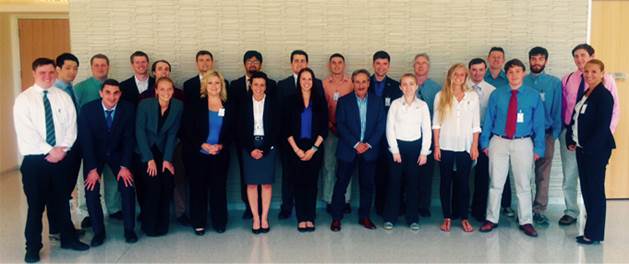Faculty News
Media Mentions:
WUSA-CBS 9 (online) quoted Prof. Amir Etemadi (ECE) in the May 15 article “Metro smoke/fire increase as parts replacement decrease.”
The New York Daily News paraphrased Prof. Samer Hamdar (CEE) in the May 13 article “If a train crashes, seats in the middle cars are safest bet: experts.”
Publications:
Prof. Rachael Jonassen (part-time faculty, EMSE and CPS) published the paper “Energy Investment Risk and Future Climate, Part II” in the May 2015 edition of the European Energy Centre journal Energy Learning. This is the second of a three-part series she is preparing on the topic, which will be published in cooperation with the United Nations Environment Programme and Centro Studi Galileo as an EEC eBook upon completion. The eBook will form the basis of a new training course on the topic.
Prof. Michael Keidar (MAE) has published the invited topical review “Plasma for cancer treatment” in the IOPScience journal Plasma Sources Science and Technology, Volume 24, Number 3.
Prof. Tianshu Li (CEE) and his postdoc Raffaela Cabriolu have published the following paper: Raffaela Cabrioulu and Tianshu Li, “Ice nucleation on carbon surface supports the classical theory for heterogeneous nucleation,” Physical Review E 91, 052402 (2015).
Conferences & Presentations:
On May 19, Prof. Tianshu Li (CEE) gave an invited seminar at Michigan Technological University’s Department of Physics. The seminar was titled “Nucleation of ice and hydrates: moving beyond direct molecular simulations.”
Research Prof. David Nagel (ECE) recently gave two similar presentations with the same title in Japan: “Low Energy Nuclear Reactions: Robust Results, Promising Potential and Critical Challenges.” The first talk on May 13 was at a workshop celebrating the initiation of a new program on condensed matter nuclear reactions at Tohoku University in Sendai. It highlighted the scientific status of LENR. The second presentation was given to approximately 100 business and government personnel in Tokyo on May 14. Commercial activities and opportunities were emphasized in that talk.
Other News:
Dr. Carl Landwehr (research scientist, Cyber Security and Privacy Research Institute) and Tom Haigh have authored the Building Code for Medical Device Software Security, a set of guidelines to help companies establish a secure baseline for software development and production practices of medical devices. The building code provides the blueprint to reduce or eliminate vulnerabilities that adversaries can exploit to gain access to medical devices. It was developed in part through NSF-funded work Dr. Landwehr did at CSPRI. The IEEE announced the release of the building code on May 18.
Student News
Mahesh Mohan, a Ph.D. candidate studying under Prof. Claire Monteleoni (CS), is first author on a paper appearing at the IEEE International Conference on Robotics and Automation (ICRA), the premier international robotics conference. Monesh will give a spotlight talk at the conference, to be held May 26-30 in Seattle, WA. The paper and authors are: M. Mohan, D. Gálvez-López, C. Monteleoni, and G. Sibley, “Environment Selection and Hierarchical Place Recognition.”
Andrew Vasko, a 2015 graduate of the CEE master’s program, won first place and a $1,000 cash prize in the annual student presentation competition organized by the ASCE national capital section geotechnical engineering committee. The competition is open to all graduate students studying at GW, Catholic University, Howard University, University of Maryland, George Mason University, and Virginia Tech. Andrew presented a summary of his master's thesis, which he completed under the direction of Prof. Majid Manzari (CEE) in spring 2015. He was one of the three finalists selected to present their works before a panel of highly experienced and prominent geotechnical engineers who practice in the Washington, DC metropolitan area. Andrew’s talk was titled “Earthquake-induced Lateral Spreading: State-of-the Art vs. State-of-Practice.”
Guest Vignette

When SEAS alumnus and NASA astronaut Dr. Charlie Camarda reached out to Prof. Michael Plesniak (MAE) last year to invite SEAS students to participate in NASA’s ICED (Innovative Conceptual Engineering Design) Epic Challenge 2014, Dr. Camarda ended up opening a window of wonderful experiences for MAE student Polly Drown. Polly had been doing research with Prof. Adam Wickenheiser, who recommended her for the workshop and the yearlong project.
Epic Challenge 2014, which is part of NASA’s Asteroid Grand Challenge, involved students from GW, NYU, Virginia Tech, Georgia Tech, and Wright State University, and it began with a weeklong program last August on the Georgia Tech campus. During the program, the 18 students were divided into teams of six and were tasked with asteroid capture, retrieval, utilization, and mitigation.
The teams worked remotely over the course of the year and then gathered at NASA Langley Research Center on May 13 to present their projects. Polly’s team project was the design of an asteroid mining mission, which included designing: the mission architecture (and doing a cost analysis); the structure and instrumentation of a lander; a regolith collection system; a gripping apparatus for the lander (which was Polly’s responsibility); and the mining and processing system.
SEAS thanks Dr. Camarda for providing this opportunity for our students.
(Information for this vignette was provided courtesy of Ms. Polly Drown, who recently graduated with a BS in mechanical engineering and a concentration in aerospace engineering.)

